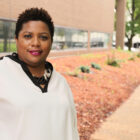Go behind the scenes of our community’s disaster response
By Regina Greer
In the wake of a disaster, every hour, every resource matters to move from crisis to recovery.
When disaster strikes, hundreds or even thousands of survivors need help with anything from cleanup to counseling, from food to housing support. Hundreds of nonprofits step forward to offer assistance, each with different expertise, programs and missions. People raise their hands to volunteer or donate but often don’t know where their help is needed most. Resources – monetary and in-kind donations, government funding, supplies and more – come pouring in.
With so many people needing help with different needs after disasters, efforts to coordinate a response are vital to help us all on the road to recovery and to ensure the right resources are delivered at the right times. But these efforts don’t just come together overnight.
It takes tremendous work behind the scenes to make sure people get the help they need quickly and effectively.
In the St. Louis region, this work is led by COADs (Community Organizations Active in Disaster). COADs bring our emergency response experts to the table, including representatives from government agencies like emergency management and human services departments; nonprofits like United Way, American Red Cross, St. Vincent de Paul and St. Louis Area Foodbank; law enforcement; and business and civic leaders.
For over a decade, through my work on United Way’s impact and disaster response teams, I’ve had the opportunity to work with COADs throughout our region and witness this important work firsthand. Here’s a look at how COADs work behind the scenes to prepare and to help our region during emergencies.
COADs plan year-round so we have a leg up when disaster strikes.
COAD members meet all year. “Blue sky times,” when we’re not up against the time constraints of a major disaster, are the best opportunity to prepare for the future. We plan disaster operations and processes, train staff and volunteers and share information so we’re ready to take action not if, but when crises arise.
It’s never possible to anticipate every detail, but it’s critical to do what we can to plan as many details and scenarios as possible. Often, the first few hours of a disaster are the most dangerous, so having basic processes and communication channels already in place is critical for saving lives and helping to stabilize communities.
COAD members collaborate for greater impact.
In the wake of a disaster, people face a variety of challenges, like finding safe places to stay, trauma counseling, childcare and more.
No one organization has all the answers. Thankfully, one of a COAD’s greatest strengths is its ability to bring partners together to address a variety of needs. Each brings its network and resources to the table, magnifying the impact of response and recovery efforts.
This makes large-scale efforts, like setting up a multi-agency resource center, possible. For this, we work to find a location big enough and convenient for people who need basic needs supplies such as food, water and personal hygiene items. We work with partners to secure other household supports, like direct financial assistance and applications for individual disaster funding, and organize volunteers to work at the site. And we work with agencies and news outlets across the region to spread the word to people who need help.
COADs communicate vital information.
COADs ensure all stakeholders are up-to-date on the community’s needs, available resources and how people can find and give help.
Each COAD member is an expert on their community and the people they serve. We share this expertise to help one another understand and address the community’s needs. For example, COADs may determine that one community may be in dire need of access to safe housing, while another may have plenty of places for people to stay, but instead needs help with debris cleanup.
This is especially important when so many well-meaning people want to volunteer or donate after a disaster. Depending on the situation, not all types of donations are needed, and having too many volunteers can create more hazards. For example, after a devastating hurricane in Honduras, one airport’s tarmac was full of donated food and clothing. Local people needed immediate medical care, but planes carrying medical supplies didn’t have room to land, and the food and clothing weren’t needed until weeks later. By knowing what people need and where it’s needed, we avoid duplicating efforts or wasting resources.
COADs are here for the long haul.
Disaster situations develop quickly, and people’s needs change over time. COADs work throughout the whole life cycle of a disaster, constantly monitoring the community’s needs to understand how to help.
With a long history of helping people in the community, COADs are experts in immediate disaster relief operations, as well as intermediate and long-term recovery efforts. Every disaster is different, so we work together to determine what it will take to move people into safe conditions, and what it means to be back on track.
As our region continues to face serious challenges, local COADs will continue to work together to provide the leadership needed to help our community recover, regain stability and advance toward their pre-disaster state.
TAKE ACTION NOW:
- If you or someone you know is in need of assistance, dial 2-1-1 or visit 211helps.org to get connected to local resources.
 Regina Greer is chief impact officer at United Way of Greater St. Louis, where she oversees United Way’s community impact strategies, including nonprofit investments, 2-1-1, collective impact, community response, volunteerism and public policy.
Regina Greer is chief impact officer at United Way of Greater St. Louis, where she oversees United Way’s community impact strategies, including nonprofit investments, 2-1-1, collective impact, community response, volunteerism and public policy.
